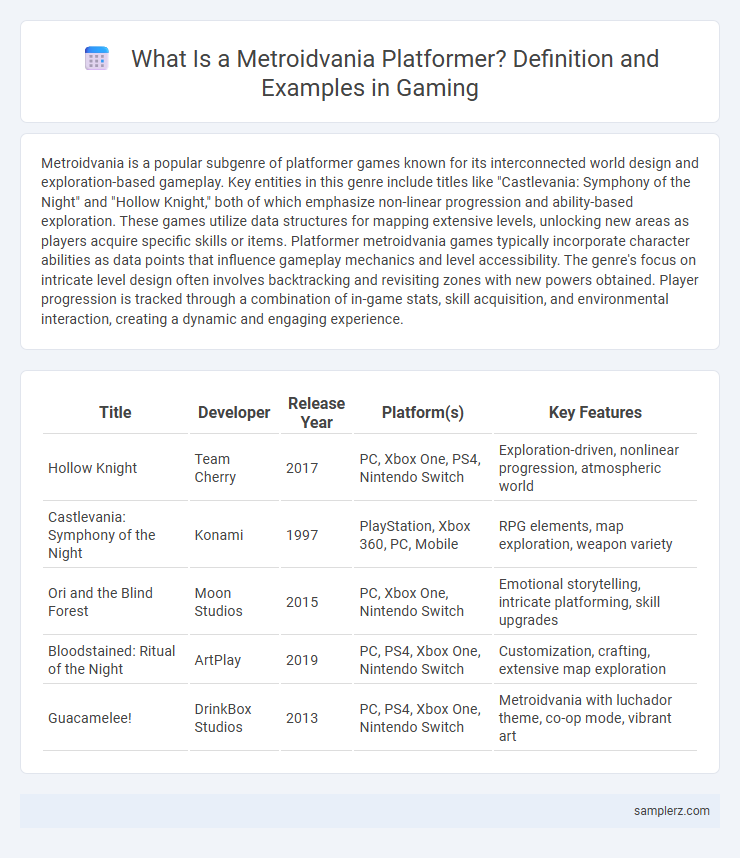Metroidvania is a popular subgenre of platformer games known for its interconnected world design and exploration-based gameplay. Key entities in this genre include titles like "Castlevania: Symphony of the Night" and "Hollow Knight," both of which emphasize non-linear progression and ability-based exploration. These games utilize data structures for mapping extensive levels, unlocking new areas as players acquire specific skills or items. Platformer metroidvania games typically incorporate character abilities as data points that influence gameplay mechanics and level accessibility. The genre's focus on intricate level design often involves backtracking and revisiting zones with new powers obtained. Player progression is tracked through a combination of in-game stats, skill acquisition, and environmental interaction, creating a dynamic and engaging experience.
Table of Comparison
| Title | Developer | Release Year | Platform(s) | Key Features |
|---|---|---|---|---|
| Hollow Knight | Team Cherry | 2017 | PC, Xbox One, PS4, Nintendo Switch | Exploration-driven, nonlinear progression, atmospheric world |
| Castlevania: Symphony of the Night | Konami | 1997 | PlayStation, Xbox 360, PC, Mobile | RPG elements, map exploration, weapon variety |
| Ori and the Blind Forest | Moon Studios | 2015 | PC, Xbox One, Nintendo Switch | Emotional storytelling, intricate platforming, skill upgrades |
| Bloodstained: Ritual of the Night | ArtPlay | 2019 | PC, PS4, Xbox One, Nintendo Switch | Customization, crafting, extensive map exploration |
| Guacamelee! | DrinkBox Studios | 2013 | PC, PS4, Xbox One, Nintendo Switch | Metroidvania with luchador theme, co-op mode, vibrant art |
Defining Metroidvania in Platformer Games
Metroidvania games are a subgenre of platformers characterized by interconnected, explorative world design that emphasizes backtracking and ability-based progression. Titles like "Hollow Knight" and "Castlevania: Symphony of the Night" exemplify this style by combining precise platforming with deep narrative and upgrade mechanics. These games emphasize player skill development through unlocking new abilities that allow access to previously unreachable areas, fostering a layered gameplay experience.
Key Features of Metroidvania Platformers
Metroidvania platformers feature interconnected, non-linear worlds that encourage exploration and backtracking, often unlocked by acquiring new abilities or tools. Key elements include a seamless map design, intricate level layouts with hidden areas, and progression tied to character upgrades like enhanced mobility or combat skills. These games balance exploration, combat, and puzzle-solving to create immersive gameplay experiences emphasizing player discovery and skill development.
Classic Metroidvania Platformer Examples
Classic Metroidvania platformers such as "Super Metroid" and "Castlevania: Symphony of the Night" define the genre with interconnected world exploration, item-based progression, and nonlinear gameplay. These titles emphasize backtracking and skill upgrades to unlock new areas, creating a deep and immersive player experience. Their design principles have influenced countless modern platformers, solidifying the core mechanics of Metroidvania in gaming history.
Indie Success Stories in Metroidvania Platformers
Hollow Knight, developed by Team Cherry, exemplifies indie success in metroidvania platformers with its vast interconnected world, challenging combat, and deep lore. Ori and the Blind Forest by Moon Studios combines stunning hand-painted graphics with fluid platforming mechanics, earning critical acclaim and a strong fan base. Salt and Sanctuary, created by Ska Studios, merges Souls-like difficulty with metroidvania exploration, showcasing innovative design that resonated with indie gamers.
Modern Innovations in Metroidvania Platformers
Modern innovations in Metroidvania platformers include dynamic procedural level design and seamless integration of RPG elements, enhancing exploration and character progression. Titles like "Hollow Knight: Silksong" showcase advanced combat mechanics and expansive, interconnected worlds that push the genre's boundaries. Enhanced visual storytelling and adaptive soundtracks further immerse players, redefining the classic platforming experience.
Iconic Characters in Metroidvania Platformer Titles
Samus Aran from the Metroid series and Alucard from Castlevania: Symphony of the Night epitomize iconic characters in Metroidvania platformers. These protagonists feature intricate abilities and exploration-based gameplay that define the genre. Their distinct skill sets and memorable narratives shape player experience and genre evolution.
Level Design Trends in Metroidvania Platformers
Metroidvania platformers emphasize intricate, interconnected level designs characterized by non-linear exploration and backtracking, often gated by abilities acquired through progression. Current trends focus on seamless map navigation, environmental storytelling, and adaptive challenges that encourage player mastery of movement and combat mechanics. Developers increasingly integrate layered secrets and shortcuts that reward exploration, enhancing replayability and immersion within rich, atmospheric worlds.
Popular Metroidvania Platformers for Beginners
Hollow Knight offers a well-balanced introduction to metroidvania mechanics with expansive maps and accessible combat. Ori and the Blind Forest provides vibrant visuals and smooth platforming, making exploration intuitive for newcomers. Dead Cells combines roguelike elements with metroidvania design, delivering a dynamic and rewarding experience for beginners.
Community Favorites: Top-Rated Metroidvania Platformers
Hollow Knight stands out as a community favorite Metroidvania platformer acclaimed for its intricate map design and challenging combat mechanics. Ori and the Blind Forest combines stunning visuals with tight platforming and emotional storytelling, earning widespread praise among fans. Dead Cells offers a rogue-lite twist on the genre, featuring procedurally generated levels that keep gameplay fresh and engaging.
Future Prospects of Metroidvania in Platformer Gaming
Metroidvania games, known for their intricate level designs and exploration-based progression, continue to influence the future of platformer gaming by integrating innovative mechanics such as non-linear storytelling and enhanced world-building. Titles like "Hollow Knight: Silksong" and "Axiom Verge 2" showcase how evolving technology enables richer atmospheric environments and more complex character abilities, driving player immersion. The growing integration of procedural generation and dynamic difficulty adjustment indicates a promising direction for expanding replayability and personalized gameplay experiences within the Metroidvania genre.

example of metroidvania in platformer Infographic
 samplerz.com
samplerz.com